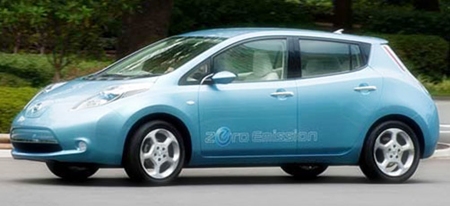It appears that every manufacturer is touting just how ‘green’ they are, with Hybrids on the lot today and EV’s just around the corner tomorrow. But is that concept one which reflects reality? Or is it some sort of hype to boost sales of these models, when their variants with internal combustion engines are cheaper?
The study ‘Drive Green 2020: More Hope than Reality’ concludes global hybrid and EV demand is likely to account for only a small proportion of total vehicle sales over the next decade, despite multi-billion-dollar investments and fast-paced development in the car industry, according to global marketing information company JD Power and Associates who commissioned the research.
 All-electric Nissan Leaf.
All-electric Nissan Leaf.
JD Power’s research postulates that hybrids and EVs combined will account for just 7.3 percent – or 5.2 million units – of the 70.9 million passenger vehicles forecast to be sold in 2020. In other words, 92 percent of new vehicles at the end of the next decade will still be gasoline/diesel powered. So much for the oil supply dwindling. JD Power’s study obviously does not feel we will be forced into driving EVs.
Dealing in ‘futures’ is at best a risky business, and some automakers who have placed their bets on the end of oil as we know it, have commenced development of EVs. Nissan-Renault, for example, is expecting EVs alone to account for around 10 percent of total vehicle sales by the end of the decade – while JD Power estimate only 1.8 percent. But even if we accept Nissan-Renault’s figures, that still leaves 90 percent conventional gasoline/diesel power.
The German manufacturers, who have a finger in many options including hydrogen power as well as EVs, stand to benefit from their government’s ‘national electro-mobility plan’ put forward in August this year that calls for a million electric cars on German roads by 2020, and more than five million by 2030.
BMW also believes EVs will account for between five and 15 percent of the new vehicle market by 2020, while Volkswagen expects electric vehicles will be three percent of its sales by 2020 – which should be well in excess of 300,000 units.
There is another factor which must now be taken into account – the new internal combustion engines are much more frugal and in fact are as good as, if not better than, most hybrids.
While past auto shows have been stocked with petrol-electric hybrids and SUVs, slow hybrid sales have brought a dose of reality. Automakers are realizing they can give buyers what they want and avoid the expense of electric motors and batteries by building smaller cars and getting better fuel economy from traditional petrol engines. In fact, Hybrid sales slowed last year to 2.2 percent of U.S. sales, from 2.4 percent in 2010. Those figures would not encourage a prospective customer to go hybrid.
A chief executive of the retail chain AutoNation Inc., said that 75 percent of customers come into his showrooms and want to talk about hybrids, but only about 2.5 percent of AutoNation sales are hybrids.
However, the last word comes from Sergio Marchionne, CEO of Fiat SpA and Chrysler Group LLC, said the skepticism over electric cars and plug-in hybrids “is well-justified.” He added, “If anyone thinks they will meet future EPA rules solely with internal combustion engines, they are smoking an illegal substance.”




